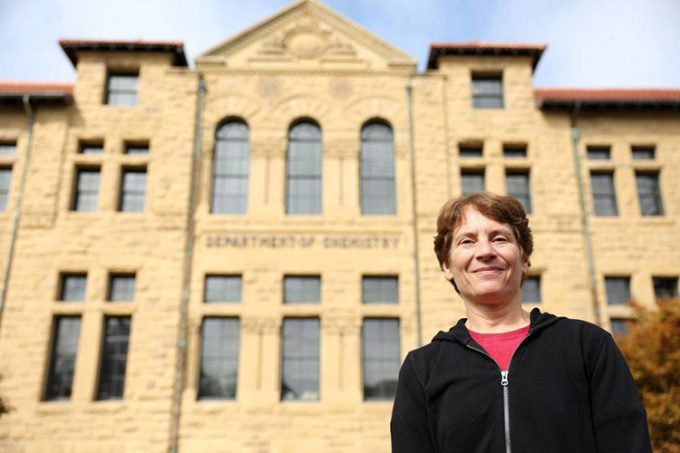Pioneering Research on Orthogonal Chemistry by Carolyn Bertozzi is Opening Up Breakthrough Methods in Cancer Treatment.
“All sorts of crazy stuff” is how Carolyn Bertozzi (56 years old), winner of the 2022 Nobel Prize in Chemistry, describes her life’s work: conducting “chemistry in cells and in the human body.”
When she began her research in 1997, the Stanford University professor aimed merely to observe the evolution of certain molecules on the surface of cancer cells. Today, thanks to her discoveries, at least two companies—one of which she co-founded—are developing innovative cancer treatment methods.
Bertozzi’s findings have numerous impressive applications, including providing highly precise treatment methods, gaining a better understanding of how drugs work inside the body, and making certain bacteria visible. “I can’t even count them all. Most of the applications I couldn’t have predicted,” Bertozzi told AFP in an interview.
The Royal Swedish Academy of Sciences recognized Bertozzi’s pioneering research on October 5, alongside Barry Sharpless and Morten Meldal, making her the eighth woman in history to win the Nobel Prize in Chemistry, at just 55 years old.

Professor Carolyn Bertozzi photographed in front of the Sapp Center for Science Teaching and Learning at Stanford University on October 5. (Photo: AFP)
Building Blocks of Science
Bertozzi’s journey began when she discovered her passion for organic chemistry while taking pre-med courses at Harvard University. This field is known to be “extremely difficult,” but Bertozzi is a “wonderful professor”—according to David Evans, a late professor at Harvard—because she brought it to life, changing the course of her life.
Bertozzi has a sister who is a professor of applied mathematics and a father who is a retired physics professor, but when asked about her dreams, she always said: “I will become a chemist.”
“If you ask me what kind of chemist, the answer is an organic biochemist. That’s the term we use to refer to chemists who create and design molecules, hoping to use them as tools to study biology,” Bertozzi shared.
After completing her postdoctoral program and joining the faculty at the University of California, Berkeley, Bertozzi wanted to closely examine how glycans (complex carbohydrates or sugars on the surface of cells) undergo structural changes as they develop into cancer.
At that time, “there were no tools to image sugars, like in microscopy.” Bertozzi had an idea: to require two chemicals to fit together perfectly, like Lego pieces.
The first Lego piece is provided to the cells via sugar. The cells then metabolize it and place it at the end of the glycan. The second Lego piece—a fluorescent molecule—is injected into the body. When the two Lego pieces fit together, the hidden glycans become visible under the microscope.
This technique is inspired by “Click Chemistry”, developed independently by Nobel Prize-winning researchers Morten Meldal (Denmark) and Barry Sharpless (USA). However, their discovery relied on using copper as a catalyst, which is toxic to the body.
One of Bertozzi’s major breakthroughs was achieving the same type of highly efficient reaction without copper, allowing everything to occur without affecting other processes in the body.
Bertozzi coined the term “orthogonal chemistry”, meaning a reaction that does not interfere with other biochemical processes. It took her ten years to perfect this technique.
The Cycle of Science
Researchers are building on Bertozzi’s breakthroughs to develop new cancer treatment methods.
“Glycans on cancer cells can hide cancer from the immune system, and thus, your body cannot see it and cannot fight it. By using orthogonal chemistry, we have created a new drug that essentially works like a lawnmower,” Bertozzi explained.
The first Lego piece attaches to the surface of the cancer cell, and the second piece, equipped with an enzyme, “cuts the sugars as if they were weeds. It mows the lawn and the sugars fall off,” the professor likened. The drug is currently undergoing early-stage clinical trials.
Another company is looking to use orthogonal chemistry to target cancer treatment more effectively. The first Lego piece is injected into a tumor, and then the second piece, carrying the drug, attaches itself and only acts on its target.
“That allows doctors to treat the tumor and destroy it without exposing the entire patient’s body to toxic chemicals,” Bertozzi added.
Hundreds of students and researchers who have participated in Bertozzi’s lab have sent congratulations to the 2022 Nobel Prize winner. Bertozzi hopes her mentoring work will provide opportunities for others to amplify the impact of science. “It’s really a cycle of science,” the researcher emphasized.


















































